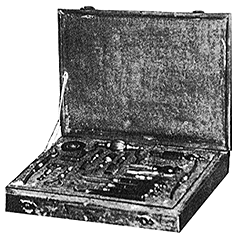
The former Emperor of France had died of probable stomach cancer on May 5, 1821, on the island of St. Helena, where he had lived in exile since 1815. But just how did the tools end up in the medical school library 114 years later?
Little is known about the fate of the instruments between Napoleon's death and 1933, when they turned up in New Orleans. They were brought there by a Frenchman, Albert Lieutaud, who told the Times Picayune that he "acquired the instruments and their case in Paris, but I am not at liberty to disclose their recent history."
According to one informed source, M. Lieutaud had procured the tools for a collector in New Orleans, but when the deal went sour he was forced to find a new buyer. Through a friend in New Orleans, Eleanor S. McRae of Atlanta heard about the tools. The wife of Floyd McRae, a visiting professor at Emory medical school and chief of surgery and chairman of the board at Piedmont Hospital, she decided to buy them for her husband as a birthday present. She paid a very modest sum.
"There wasn't any sense in my father keeping them in the house where nobody could see them . . . so he thought of Emory medical school," says Floyd McRae Jr., the son of Dr. McRae, who died in 1972. The instruments were on view for a number of years at Emory, and when they were returned to McRae in the late 1960s, he gave them to his son, who is a retired Air Force colonel and avid military historian.
McRae thought the tools deserved a wider audience than the medical school's library offered, and he set about finding an appropriate place to display them. "First of all, I thought about the Smithsonian, then I thought about West Point and the Air Force Academy, places that might be suitable for [the instruments] to be displayed to the public," he says. "But none of them seemed as suitable as the Invalides [the French Army museum] in Paris, where a lot of other Napoleonic memorabilia is. So I wrote the French embassy, and I asked who was the governor of the Invalides, and they told me. So I wrote to him, and then the correspondence became thick and heavy."
McRae admits he was apprehensive about contacting the French government for fear he might be unwittingly deceiving them. "I was not sure these instruments were really legitimate, and I had a lot of concern," he says. "I thought, Is the French government going to look at these things and say they were made in Hong Kong thirty years ago?"
To avoid any embarrassment, McRae sent photographs of the instruments and the case in which they were contained to the Invalides for inspection. When French officials saw the name of Francesco Antommarchi, the surgeon who had performed the autopsy, and four imperial eagles stamped on the outside of the case, they were convinced. McRae said they wrote him back and informed him that "these instruments probably accompanied the Emperor on his Russian campaign. . . . These were part of the imperial baggage, and they accompanied Napoleon wherever he went, and so they accompanied him to St. Helena."
On April 25, 1972, the instruments, which are still owned by McRae, were presented in a ceremony at the Invalides, where they remain on extended loan. Next to the display a plaque reads, "Given by Colonel Floyd McRae, United States Air Force." Of their long-term fate, McRae says, "they will probably be willed to one of my sons, and what he does with them will be up to him."--J.D.T.